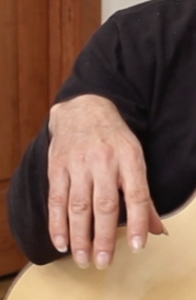Single String Etude #4 | thumb rest or free stroke?

Rest or free stroke?
The thumb is a remarkable digit that can easily move between rest or free stroke with striking musical results. A precise angle of approach to the string combined with a small tempo change can change the entire mood of a piece. Single String Etude #4 provides an easy way to experiment and gain insight into subtle changes of hand position. The secret, of course, is in balancing the position to achieve beautiful and musically sensible tone and dynamics in both thumb and fingers. This is the path to expand expressive capabilities.
Natural position of the hand
While the thumb is the focus of this piece and the video above, there is also discussion of the balance between melody and accompaniment. In anatomical terms, that is the position and angle of attack of the thumb opposing the fingers. So the thumb must accomplish its goal of realizing a beautiful melody, while the fingers remain loose but controlled. They must, in this piece, strike two strings precisely at once with the desired dynamic and tone.
 The accompaniment may seem unimportant, but it is sometimes the things that we don’t want the listener to focus on that create a more subtle effect. So in order to keep the fingers effectively doing their job, it is important to keep them in touch with each other. To understand this fully, it is crucial to realize the natural tendency of the fingers to separate when the wrist is flexed, and to overlap each other when the wrist is extended. Players often have a slightly arched wrist and the result can be that the fingers separate ever so slightly. This inevitably, even in very fine players, leads to a thinner sound in free strokes.
The accompaniment may seem unimportant, but it is sometimes the things that we don’t want the listener to focus on that create a more subtle effect. So in order to keep the fingers effectively doing their job, it is important to keep them in touch with each other. To understand this fully, it is crucial to realize the natural tendency of the fingers to separate when the wrist is flexed, and to overlap each other when the wrist is extended. Players often have a slightly arched wrist and the result can be that the fingers separate ever so slightly. This inevitably, even in very fine players, leads to a thinner sound in free strokes.
The fingers are at their optimum position for movement and for sound when the wrist is relatively straight. The fingers touch each other and are not yet separated. A more accurate approach to the string is accomplished. The result of this position is a fuller tone. Two and three note chords, played with only the fingers as is typical in accompaniments, benefit greatly with this knowledge.
Watch the video to see these positions more fully demonstrated.
Previous video:
Single String Etude #3 – vibration in the top
Watch/read the about the series: Single Strings Etudes
Recent Comments